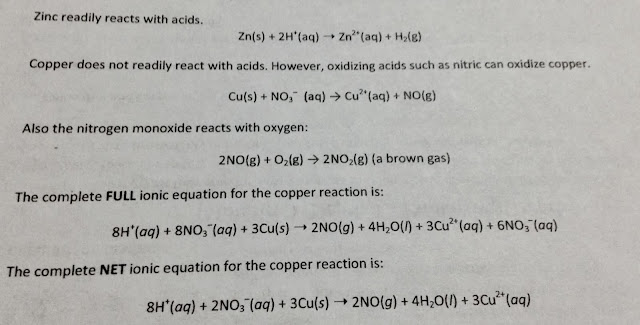This is the Chemical reaction:
We came up with this equation:
We then created and executed a procedure to find the absorbance of the Cu solution created in the reaction. To do this we created a calibration curve for a standard solution of Cu. We then created 4 other dilutions of the standard solution and took a reading of their absorbance in order to plot a calibration curve. The dilutions used were 1/2, 1/4, 1/8, and 1/16. We also took a reading of the absorbance of our reaction solution.
Another way that we compared our reaction solution to the standard solution is by the visual comparison test. This is a test where the colors of the two solutions are compared together over a white piece of paper. If the standard solution is darker than the reaction solution, a small amount of the standard solution can be taken out until it is the same color as the reaction solution. The equation to calculate this is:
(Molarity1) (Depth1) = (Molarity 2) (Depth 2)
The next thing that we talked about this week was bond order and bond strength. We did a few POGILs that will be listed below:
Bond Order and Bond Strength
Lewis Structures (II)
These POGILs helped us to understand basic concepts of bond strength and bond order. This includes learning that double bonds are stronger than single bonds and triple bonds are stronger than single and double bonds. The stronger the bond, the more energy needed to break it.
We also learned about electron deficiency and hypervalancy:
There are two elements that have electron deficiency. B is full when it has 6 electrons and Be is full when it has 4 electrons.
Hypervalancy is when a central atom in a molecule has more than an octet. This can happen with all elements that are in the 3rd period or higher because of the d block.
Later in the week we talked about formal charge. We learned that formal charge can be calculated for each element by using the following equation:
Formal Charge= # Valance Electrons -[# bonds + # nonbonded electrons]
-# of valance electrons: count the # as you have been doing
-# of bonds: the total number of bonds to the atom in question
-# of unshared elections: total # of unshared electrons around the atom in question
The last thing that we talked about was VSEPR Theory. VSEPR stands for valance shell electron pair repulsion. We learned that the shape of molecules are determined by the valance electron pairs.We baldid the VSEPR Theory Lab which investigated the idea of taking the Lewis structures and creating a 3D model of the central atom's bonds. For this activity we created the model from balloons.
Over all I thought that I understood the information from this week pretty well. I would give my understanding a 7/10. This is because I understand the basic concepts of bond order, bond length and VSEPR. I also still don't understand how to do all problems that deal with bond order because I find that it is hard to understand. I'm also still trying to grasp the formal charge and how that effects the shape of the molecules. Besides those two things I think that I'm understanding the material.





No comments:
Post a Comment